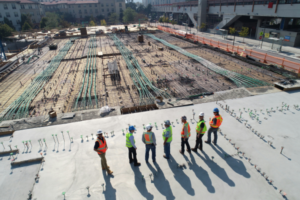Understanding Construction Software Estimating: An Introduction
Construction software estimating is a specialized tool that revolutionizes the way contractors estimate costs and manage their construction projects. This section provides an in-depth understanding of construction software estimating, its purpose, and how it works.
What is Construction Software Estimating?
Construction software estimating refers to the use of computer programs and technology to calculate and generate accurate estimates for construction projects. These software solutions are designed to streamline the estimating process, improve accuracy, and enhance overall project management.
The Purpose of Construction Software Estimating
The primary purpose of construction software estimating is to provide contractors with a reliable and efficient method for estimating project costs. By leveraging advanced algorithms and databases, this software helps contractors calculate material quantities, labor costs, equipment expenses, and other factors involved in construction projects. The result is a detailed, itemized cost estimate that serves as the foundation for project planning, budgeting, and decision-making.
How Does Construction Software Estimating Work?
Construction software estimating relies on a combination of inputs, algorithms, and databases to generate accurate estimates. The software typically includes a user-friendly interface where contractors can input project-specific details, such as project scope, site conditions, and desired materials. The software then calculates the estimated costs based on predefined formulas and algorithms, which take into account factors such as material prices, labor rates, productivity rates, and equipment costs.
To ensure accuracy, construction software estimating often integrates with external data sources or cost databases, providing up-to-date and region-specific cost information. The software may also allow for customization, enabling contractors to adjust parameters and variables to reflect their specific project requirements.
The Benefits of Construction Software Estimating
Construction software estimating offers numerous benefits to contractors and construction companies. Some of the key advantages include:
- Improved Accuracy: Construction software estimating eliminates the risk of human errors that are common in manual estimating processes. By automating calculations and leveraging accurate data, the software provides precise cost estimates, reducing the chances of over or underestimating project costs.
- Time Savings: Manual estimating methods can be time-consuming, requiring extensive calculations and referencing various sources. Construction software estimating streamlines the process, allowing contractors to generate estimates quickly and efficiently. This time savings enables contractors to dedicate more time to other critical aspects of project management.
- Enhanced Cost Control: Construction software estimating provides contractors with a comprehensive breakdown of costs, allowing for better cost control and management. Contractors can closely monitor expenses, track variations, and make informed decisions to stay within budget.
- Increased Efficiency: With construction software estimating, contractors can generate estimates with greater efficiency, reducing the time and effort required. The software automates calculations, eliminates redundant tasks, and provides a standardized approach to estimating, resulting in improved overall efficiency.
- Transparency and Communication: Construction software estimating promotes transparency in cost estimation. Contractors can provide detailed and itemized estimates to clients, stakeholders, and team members, fostering better communication and understanding. This transparency builds trust and helps manage expectations throughout the project lifecycle.
Understanding the concept and benefits of construction software estimating is essential for contractors looking to streamline their estimating processes and improve project outcomes. In the next sections, we will explore the specific benefits and features of construction estimating software in more detail.
Benefits of Using Construction Estimating Software
Construction estimating software offers a wide range of benefits that revolutionize the way contractors estimate costs and manage their projects. In this section, we will explore the key advantages of using construction estimating software in detail.
1. Improves Accuracy
One of the primary benefits of using construction estimating software is improved accuracy in cost estimation. Manual estimating methods are prone to human errors, which can result in costly mistakes. Construction estimating software automates calculations, eliminates manual errors, and ensures consistent and precise estimates. By relying on accurate data and advanced algorithms, contractors can generate more reliable estimates, reducing the risk of over or underestimating project costs.
2. Saves Time
Time is a valuable resource in the construction industry, and construction estimating software helps contractors save significant amounts of it. Manual estimating methods involve complex calculations, referencing multiple sources, and repetitive tasks. Construction estimating software streamlines the process by automating calculations, providing access to comprehensive databases, and offering pre-built templates and libraries. Contractors can generate detailed estimates in a fraction of the time it would take to do it manually, allowing them to focus on other critical aspects of their projects.
3. Enhances Cost Control
Cost control is crucial for the success of any construction project. Construction estimating software provides powerful tools that enable contractors to monitor and control costs more effectively. The software allows for accurate tracking of expenses, enables real-time cost analysis, and provides insights into project variations. With this information at their fingertips, contractors can make informed decisions, identify cost-saving opportunities, and take proactive measures to keep projects within budget.
4. Promotes Transparency
Transparency is essential in the construction industry, particularly when it comes to cost estimation. Construction estimating software promotes transparency by providing detailed and itemized cost breakdowns. Contractors can showcase the various cost components to clients, stakeholders, and team members, ensuring clear communication and understanding. This transparency builds trust, enhances collaboration, and helps manage expectations throughout the project lifecycle.
5. Streamlines Collaboration and Communication
Construction estimating software facilitates better collaboration and communication among project stakeholders. Contractors can create and share accurate estimates with clients, architects, engineers, and subcontractors, ensuring everyone is on the same page. The software allows for easy revision and updates to estimates, making it simple to communicate changes and modifications. This streamlined collaboration leads to smoother project execution, reduced misunderstandings, and improved overall project outcomes.
6. Enables Data-Driven Decision Making
Construction estimating software provides access to valuable data and analytics that empower contractors to make data-driven decisions. The software generates detailed reports, cost analyses, and comparisons between estimated and actual costs. By leveraging this information, contractors can identify trends, assess project performance, and make informed decisions to optimize project outcomes. This data-driven approach leads to improved efficiency, productivity, and profitability.
In summary, construction estimating software offers numerous benefits to contractors, including improved accuracy, time savings, enhanced cost control, transparency, streamlined collaboration and communication, and data-driven decision making. By leveraging these advantages, contractors can optimize their estimating processes, improve project management, and achieve greater success in their construction projects.
Key Features to Look for in Construction Estimating Software
When selecting construction estimating software for your business, it is important to consider the key features that will best meet your needs. In this section, we will explore the essential features to look for in construction estimating software.
1. User-friendly Interface
A user-friendly interface is crucial when it comes to construction estimating software. Look for software that is intuitive and easy to navigate, with clear menus and icons. The software should have a logical workflow that guides users through the estimating process, making it accessible to both experienced estimators and those new to the software. A user-friendly interface reduces the learning curve, increases productivity, and ensures that your team can quickly adapt to the software.
2. Integration Capabilities
Construction estimating software should have the ability to integrate with other software systems commonly used in the construction industry. Integration with accounting software, project management software, or procurement systems allows for seamless data sharing and streamlines workflow. Look for software that offers APIs or pre-built integrations with popular software platforms to ensure smooth communication between different systems.
3. Detailed Cost Libraries
A comprehensive and up-to-date cost library is an essential feature of construction estimating software. The software should provide a wide range of pre-defined cost items, including materials, labor rates, equipment costs, and subcontractor rates. The cost library should be customizable, allowing you to add or modify cost items to align with your specific project requirements. Ensure that the software includes regional or location-specific cost data to ensure accurate estimates for your projects.
4. Automated Calculations
Automation is a key feature that sets construction estimating software apart from manual methods. Look for software that automates complex calculations, such as material quantities, labor hours, and equipment costs. The software should also have built-in formulas and algorithms that consider factors such as productivity rates, waste factors, and markups. Automated calculations not only save time but also reduce the risk of errors and ensure consistent and accurate estimates.
5. Reporting & Analytics
Construction estimating software should provide robust reporting and analytics capabilities. Look for software that generates detailed reports, cost breakdowns, and analysis of estimated versus actual costs. The software should offer customizable report templates and the ability to export reports in various formats, such as PDF or Excel. Additionally, advanced analytics features, such as cost trending, variance analysis, and profitability analysis, can provide valuable insights into project performance and help you make data-driven decisions.
6. Mobile Compatibility
In today’s digital age, mobile compatibility is becoming increasingly important. Look for construction estimating software that offers mobile apps or web-based access, allowing you to access and use the software on the go. Mobile compatibility enables field estimators to input data, access cost libraries, and generate estimates directly from the construction site. This feature enhances efficiency, collaboration, and real-time decision-making.
7. Customer Support and Training
Lastly, consider the level of customer support and training provided by the software vendor. Look for vendors that offer comprehensive training programs, documentation, and online resources to help your team learn and utilize the software effectively. Additionally, ensure that the vendor provides reliable customer support, including technical assistance, software updates, and prompt response to inquiries or issues.
By considering these key features, you can select construction estimating software that aligns with your business requirements and helps you streamline your estimating processes, improve accuracy, and enhance overall project management.
How to Implement Construction Estimating Software
Implementing construction estimating software requires careful planning and execution to ensure a smooth transition and maximum utilization of the software’s capabilities. In this section, we will guide you through the steps to successfully implement construction estimating software in your organization.
1. Define Your Requirements
Before implementing construction estimating software, it is crucial to define your specific requirements and objectives. Assess your current estimating processes, identify pain points, and determine what you want to achieve with the software. Consider factors such as the size of your organization, the complexity of your projects, and the number of estimators who will be using the software. This information will help you select a software solution that best fits your needs.
2. Select the Right Software
Once you have defined your requirements, it’s time to research and select the right construction estimating software for your organization. Consider factors such as the software’s features, compatibility with your existing systems, user-friendliness, and cost. Read reviews, request demos, and engage with software vendors to get a better understanding of each software’s capabilities and suitability for your organization. Take your time to make an informed decision and choose a software solution that aligns with your goals and budget.
3. Train Your Team
Implementing construction estimating software successfully requires proper training for your team. Ensure that all estimators and relevant staff members receive comprehensive training on how to use the software effectively. This training may include understanding the software’s interface, inputting data, utilizing cost libraries, generating estimates, and interpreting reports. Depending on the complexity of the software, it may be beneficial to provide ongoing training and support to ensure that your team can maximize the software’s potential.
4. Import Existing Data
To streamline the implementation process, consider importing existing data into the construction estimating software. This may include cost data, project templates, or historical estimates. By importing existing data, you can save time and resources and ensure consistency across your estimating processes. Work with the software vendor to determine the best method for importing data and ensure that the data is accurately transferred into the software.
5. Pilot and Refine
Before fully integrating the construction estimating software into your organization, it is advisable to conduct a pilot phase. Select a small project or a few estimators to test the software’s functionality and assess its effectiveness. During this phase, gather feedback from the users and identify any areas for improvement or additional training needs. Use this feedback to refine your processes and make necessary adjustments before rolling out the software to the entire organization.
6. Monitor and Improve
Once the construction estimating software is fully implemented, it is important to continuously monitor its usage and effectiveness. Regularly review the software’s performance, gather feedback from users, and identify any challenges or areas for improvement. Stay updated with software updates and enhancements provided by the vendor, as these can further enhance the software’s capabilities. Actively seek feedback from your team and encourage open communication to ensure that the software is meeting your organization’s needs and driving positive outcomes.
By following these implementation steps, you can effectively integrate construction estimating software into your organization, streamline your estimating processes, and maximize the benefits of the software. Remember that successful implementation requires ongoing support, training, and a willingness to adapt and optimize your processes to fully leverage the capabilities of the software.




